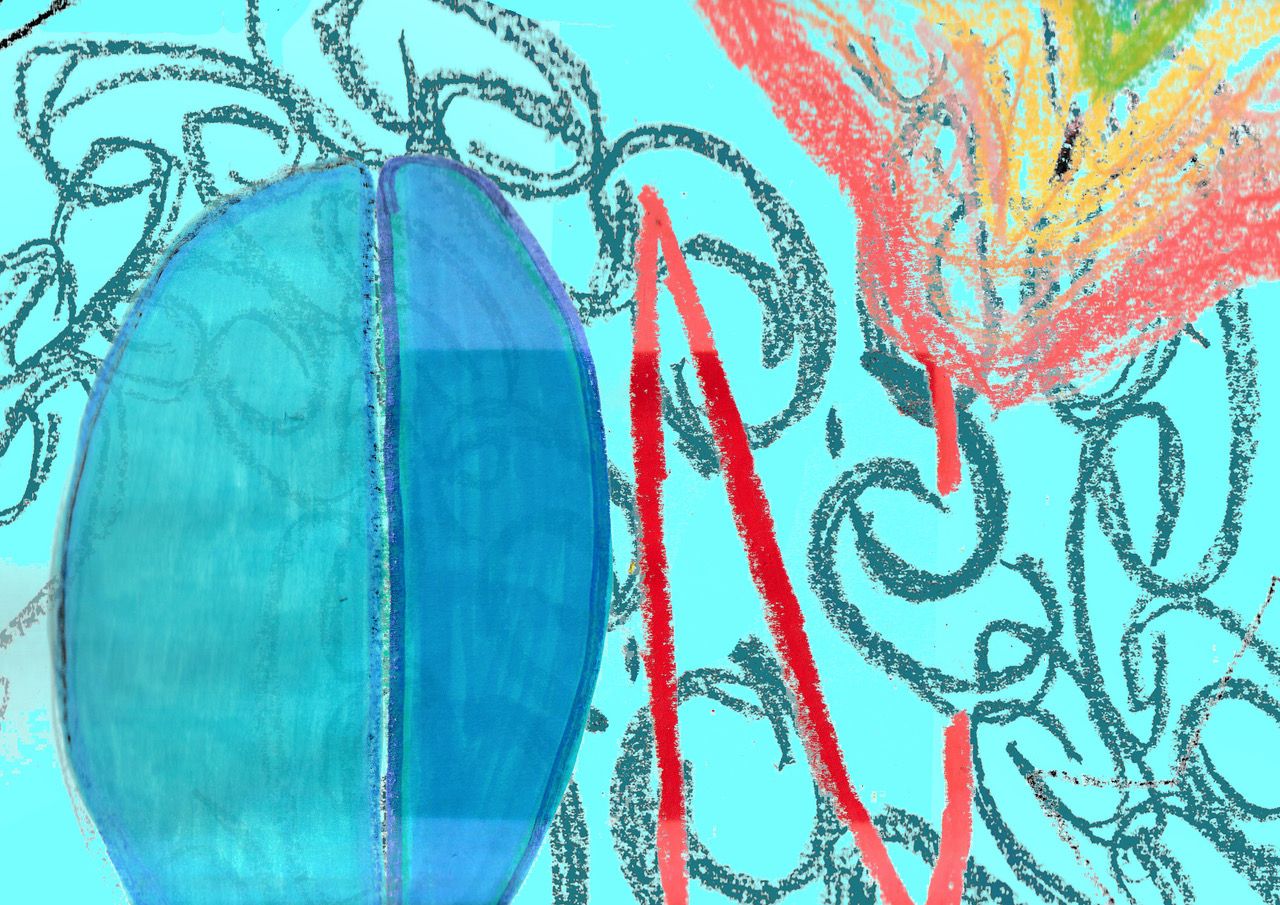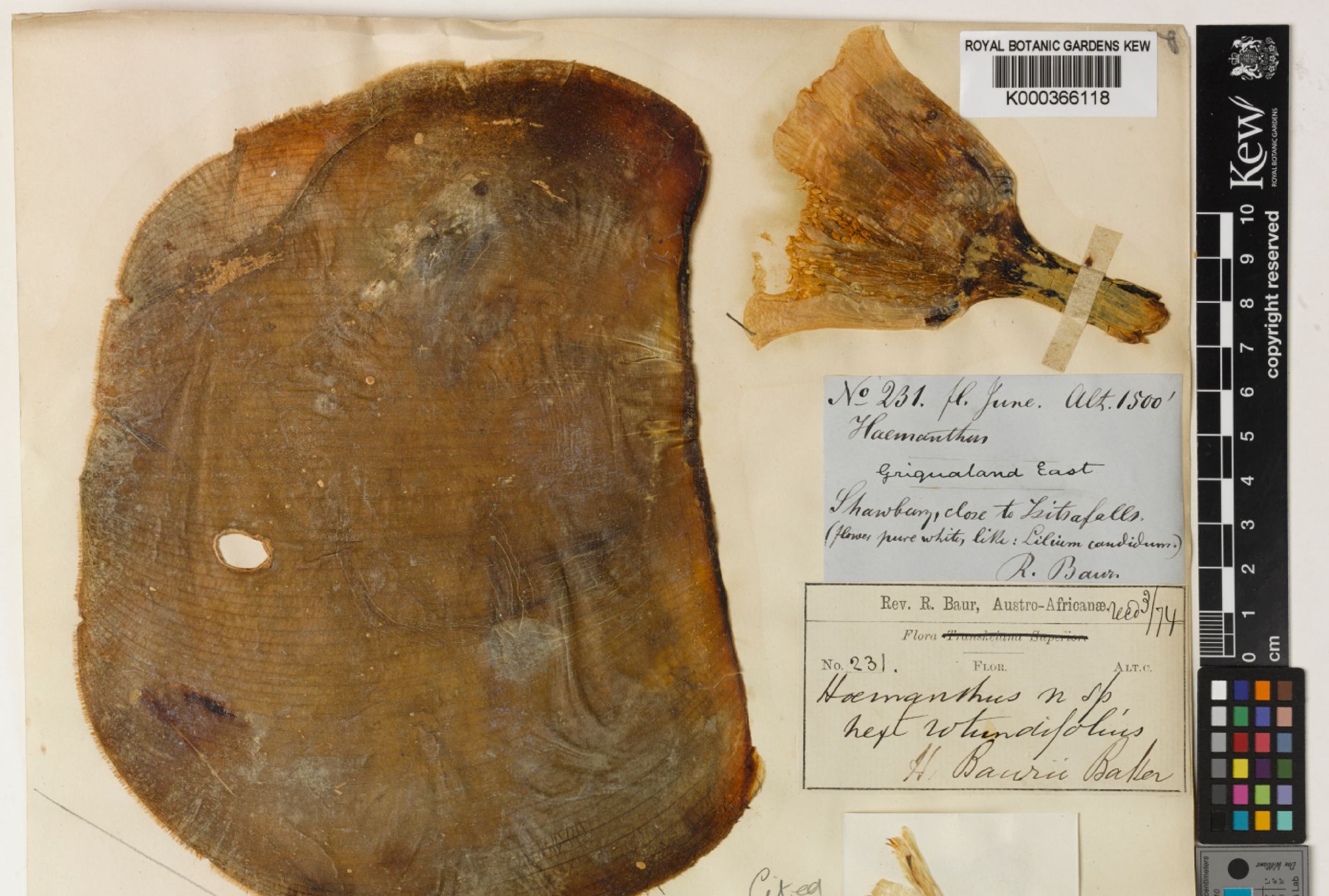
The golden age of botanical sciences is a direct consequence of European colonial exploration—and this is not an overstatement.
Picture this: a group of white oligarch men, fleeing the European winter and heading South. Taken by an adventurous attitude and the decision to write their names in the history books, they enter the forest entrusted by the colonial administration to depict the unfamiliar landscape, and—with their Western magnifying glasses—to describe its inhabitants, fauna, and flora. Their braveness and audacity will be celebrated for ages, whereas the very presence of enslaved people carrying their heavy supply crates and spotting the most valuable specimens in the forest remains, to this day, unnoticed.
In the 19th century, this scene was by no means uncommon; rather, it was the conventional way in which naturalists and hobby explorers carried out scientific expeditions to identify, describe, and catalogue “new” plant species, inaugurating what is known today as the modern botanical sciences. In this context, “discovering” a new plant not only contributed to the advancement of sciences, but also represented an opportunity for self-expression which shaped our knowledge about the so-called “natural world”—itself a Western fabrication rooted in the individualistic bourgeois ideal of domination of culture over nature.
“naming choices once more erased the plant’s exuberance and connection to its ecosystem, and instead, paid homage to male figures”
By naming a plant still unknown to the European gaze, botanists could express their personal taste and aesthetic preferences. A basic search on the Royal Botanic Gardens Kew digital repository for plants with “ugly” (deformis in Latin) in their names, gives us 23 results. One of them is Haemanthus deformis, a succulent native to South Africa that was first catalogued in 1871 by the British botanist and explorer Joseph Dalton Hooker. With two opposite long leaves lying flat on the ground, this plant might have shocked the colonial European sense of aesthetics—but naming it “ugly” reveals more about the reductionist thinking of the European botanist than anything about the plant itself.
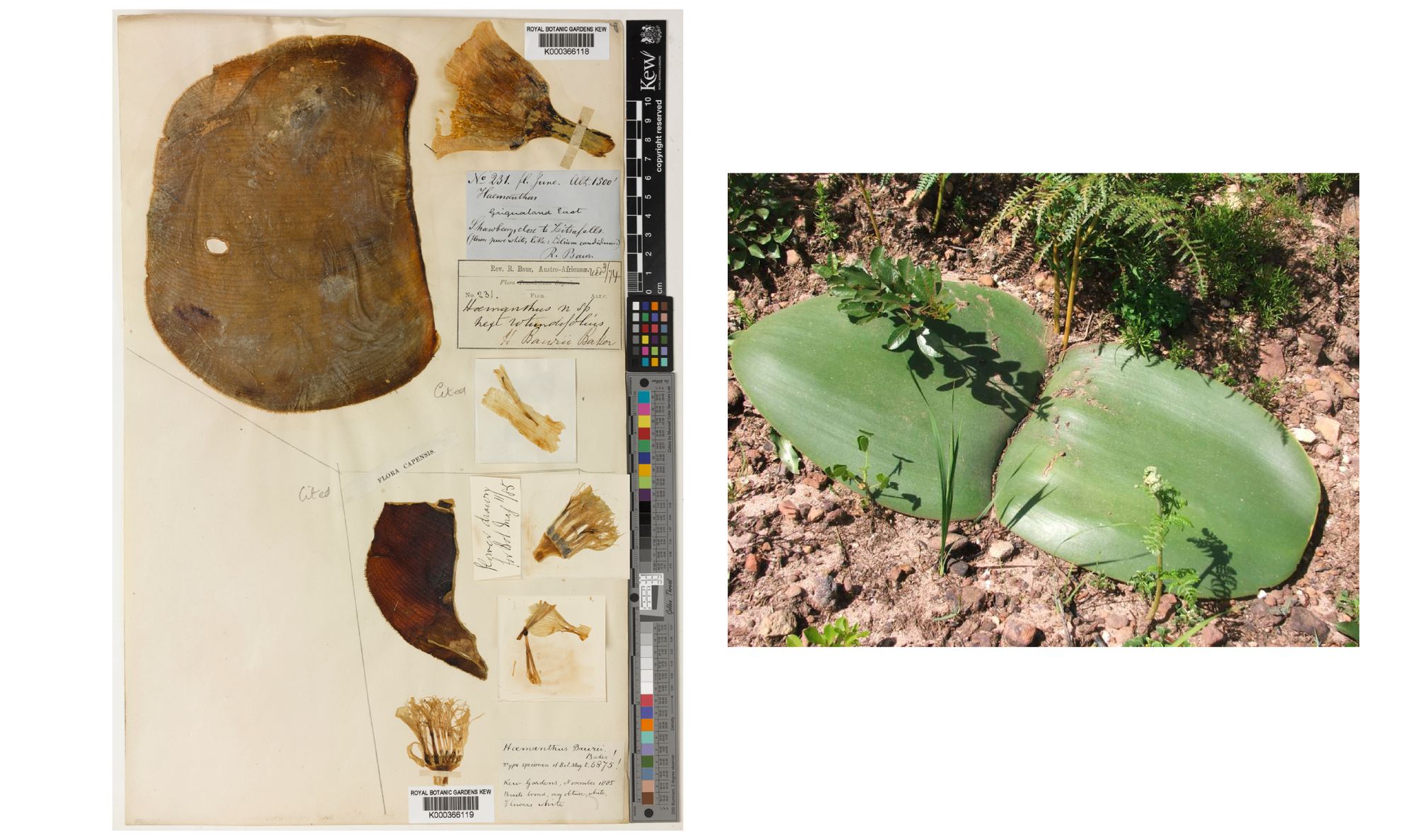
Later, the same plant called the attention of two other explorers, who thought they were the first European naturalists to “discover” it. Their naming choices once more erased the plant’s exuberance and connection to its ecosystem, and instead, paid homage to male figures. John Gilbert Baker called it Haemanthus mackenii, in reference to an unknown male named McKen, while South African explorer R. Baur proudly named it Haemanthus baurii, after himself. Today this practice of self-naming is discouraged, but in the 19th century, when the modern biological naming system was still about to be consolidated, it was quite normal. Other than a chance for egocentric bragging, giving plants names of persons is a social device used to strengthen relationships with other peers or to acknowledge affiliations, as well as to express affection to relatives, and appreciation for patrons.
Colonial stories between taxonomy lines
I first noticed the power structures latent in botanical naming in the last year of my second Bachelor’s degree at the Technical University in Berlin, where I studied computer science. Before coding, I was a journalist and a filmmaker with social sciences and visual arts inclinations. Learning to program brought me a completely new approach to storytelling. Now I was able to see stories emerging from unstructured data, scatter graphs, and relational databases.
“By looking at the existing information, one can read between the lines and identify plant stories that connect the plant cataloguing and naming process to the colonial enterprise”
The presence of European name references in scientific terminology came to my attention when trying to trace a “natural history” of the place I come from in Brazil, the beautiful mountain range landscape that is part of my childhood memories: the Serra dos Órgãos National Park in the state of Rio de Janeiro. I started to research historical representations of this region and discovered that some of its first visual depictions were made during scientific expeditions in the early 19th century, when Brazil, then still a colony of Portugal, started to allow foreign scientists to visit and explore the country. I decided to develop a framework to identify relationships between botanical sciences and colonialism, and came up with the idea for named after Men (naM).
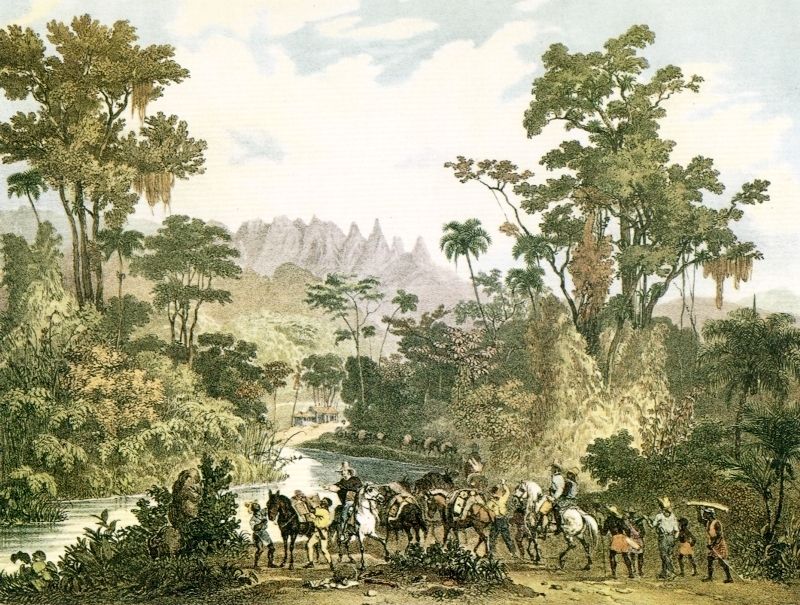
Every day, the naM website publishes a different plant named after a male botanist. In these daily posts, plants tell in first person what botanical databases have to say about them: the year they were catalogued, the names they were given, and the men they are supposed to honor with their existence. Each post also indicates where plants are “native to”; this information is collected in a tag cloud showing the regions of the planet from which most featured plants come from. Some of the plants and botanists are linked to their Wikipedia articles, enabling a deeper dive into their official stories. By looking at the existing information, one can read between the lines and identify plant stories that connect the plant cataloguing and naming process to the colonial enterprise.
This storytelling framework showed its efficacy in its very first post: the short story of Ficus erecta, written automatically by the algorithm using structured data from a botanical database:
“#1 They called me Ficus erecta, also known as Ficus taquetii, and Ficus sieboldii. I pay homage to the male botanists Taquet (I couldn’t find his records), and Philipp Franz von Siebold, or Karl (Carl) Theodor Ernst von Siebold. They first catalogued me in 1786.”
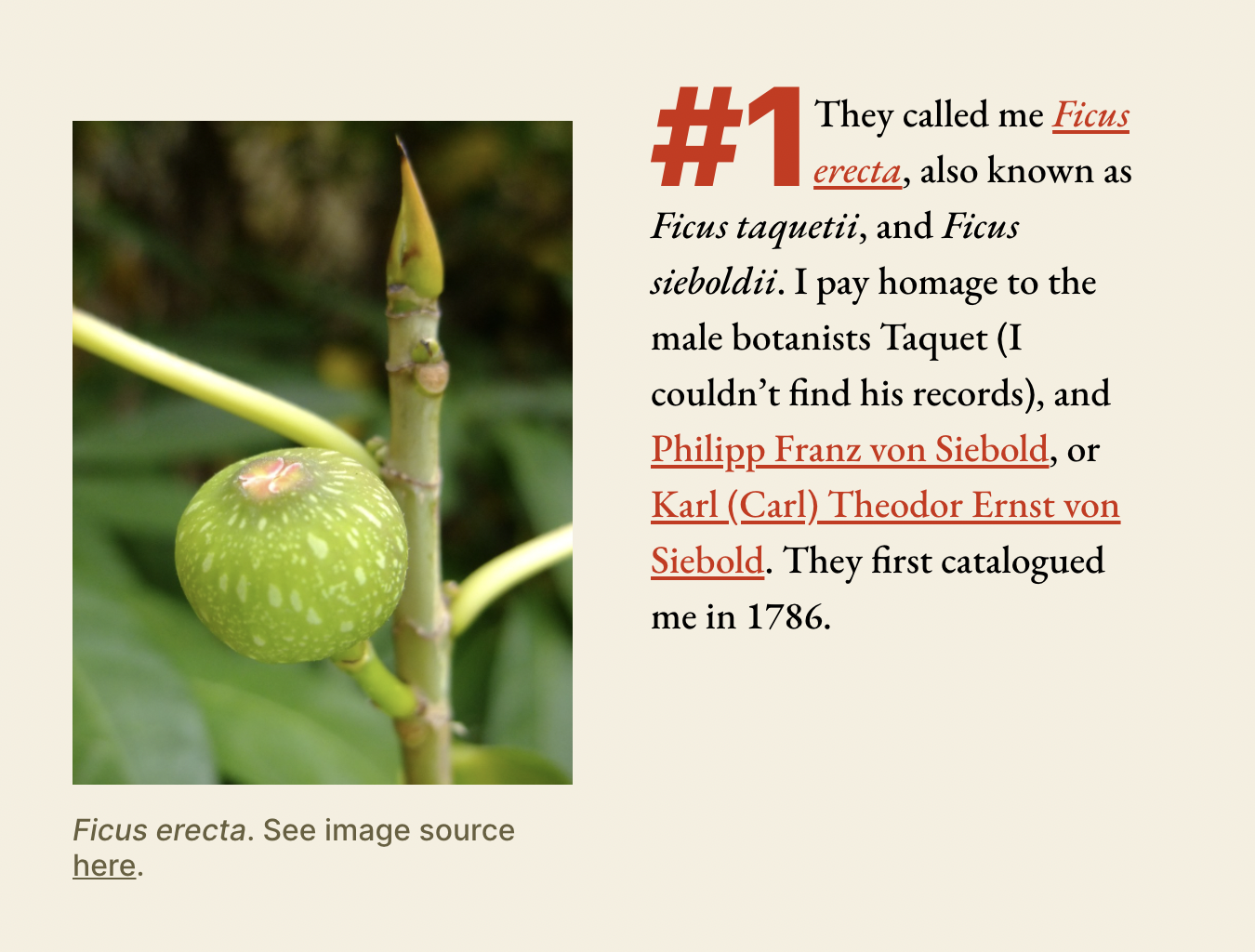
Ficus erecta is a shrub or tree from the fig family originally found in Japan, China, Taiwan, and Vietnam. It can grow from two to seven meters tall, and its edible blackish purple fruits depend on a species of wasp to ripen, building a mutual relationship in which the wasp fertilizes the plant, and the fig hosts the baby wasp. In 1786, Ficus erecta was observed and catalogued for the first time by the Swedish naturalist Carl Peter Thunberg who was working for the Dutch East India Company (VOC) at Dejima, a small artificial island in the Bay of Nagasaki in Japan, then used as a trading post. After studying at Uppsala University, Thunberg was encouraged by his teacher Carl Linnaeus, known as the “father” of modern biology taxonomy, to travel to Amsterdam to continue his studies, which is why he found his way to the VOC.
The plant would be “rediscovered” 80 years later by the Dutch botanist Friedrich Anton Wilhelm Miquel, who mistakenly catalogued a Ficus erecta plant exemplar as Ficus sieboldii. Although the naming attempt has not been accepted because the plant was already known by scientists, it can still be interpreted as a posthumous homage. The honored man—the German physician, botanist, and traveler Philipp Franz von Siebold—died in 1866, the same year in which Miquel registered what he believed was a new plant species.
Unlike Siebold, Miquel was not a traveler; instead, he dedicated his life to plant taxonomy. At the time of Siebold’s death, Miquel was the director of the National Herbarium of the Netherlands, and received the responsibility to finalize Siebold’s legacy, a book about Japanese plants called Flora Japonica. Siebold’s prestige in the botanical field was due to his big contributions to the Hortus Botanicus of Leiden in the form of several boxes of plants and stuffed animals from Japan, before being permanently banned from that country in 1829.

Siebold was an army medical officer for the Dutch East Indies, a Dutch colony in East Asia which became what we know nowadays as Indonesia. Siebold’s trajectory has some similarities to Thunberg’s, the first naturalist to catalogue Ficus erecta. Both were doctors and both started their careers in the Dejima trading post in Japan—Siebold in 1823, and Thunberg some 50 years earlier. During his six years working for the Dutch in Japan, Siebold was involved in several documented illegal activities. He smuggled Japanese tea plant seeds without governmental consent and started the tea culture in Java, which was then part of the Dutch East Indies. He also bought detailed maps from Korea and Japan, which for state security reasons was strictly forbidden, resulting in his ban from Japan under the accusation of espionage.
Siebold was also responsible for introducing the Japanese knotweed in Europe and North America, an invasive weed which damages all kinds of concrete foundations, causing, for instance, the weakening of flood defences, and encouraging fires. It is estimated that his biopiracy and trading activities resulted in at least three shipments of plant specimens, hunted rare animals, and Japanese “ethnographic objects” to the Netherlands. Siebolds’ colonial smuggling gave birth to the National Museum of Ethnology in Leiden, and contributed to the collections of the Naturalis Biodiversity Center, in the same Dutch city. As a recognition of his services to the Dutch colonial empire, Siebold is celebrated in the naming of at least 13 other plant species and two animals.
Celebrating oppression remains the default
Unfortunately, naming plants after “colonizers” is still common practice in the botanical sciences. In 2021, German and Belgian scientists from the Koblenz-Landau University have identified a new tree species from the mahogany family that can attain up to 30 meters in the Rwanda mountain rainforest. According to a Spiegel.de reportage, the proud scientists defined their “discovery” of a new tree species in the 21st century as a “real sensation.” However, by naming it Carapa wohllebenii, they followed a dated 18th century naming approach. The name is a homage to the German forester and best-seller author Peter Wohlleben “in recognition of his passion and his engagement for trees, forests, and nature conservation.”
This attitude is especially outrageous in light of the violent colonial history of Rwanda, which was part of the German East Africa colony from 1899 until the German defeat in World War I. During this period, Germany started to instigate racial divisions in the Rwandan society, a practice also adopted and refined by Belgium after WWI. The ideology of racial superiority spread by Germans and Belgians would culminate in the 1994 Rwandan genocide in which more than 800,000 Tutsi people were killed. With this gesture, German scientists missed a big opportunity of celebrating Rwandan survivors and their efforts to reconstruct their country and protect biodiversity.
“Unfortunately, naming plants after ’colonizers” is still common practice in the botanical sciences. [...] [And] Once a name has been given to a plant, it can rarely be changed.”
Scientific plant names must be unique and are only accepted as valid after being published in a scientific journal. Moreover, the names must be in accordance with the guidelines presented in the International Code of Nomenclature for algae, fungi, and plants, also known as the Shenzhen Code. Once a name has been given to a plant, it can rarely be changed. Exception to this rule is when a plant species is moved from one genus to another by a taxonomist—that is, a scientist specialized in classifying organisms according to their morphological and physiological attributes. The renaming of a plant must be judged by a committee from the International Association for Plant Taxonomy, which is responsible for safeguarding the code.
The code, however, is more concerned with keeping order in the categorization of species and ensuring the correct usage of Latin suffixes and orthography. According to paragraph 23.2, “The epithet in the name of a species may be taken from any source whatever, and may even be composed arbitrarily.” From this perspective, the code could be described as “content agnostic.” As expressed in paragraph 51.1, “A legitimate name must not be rejected merely because it, or its epithet, is inappropriate or disagreeable, or because another is preferable or better known (but see Art. 56.1 and F.7.1), or because it has lost its original meaning.”
Changing perspectives to rethink naming practices
A popular argument is that there is no reason to worry, because scientific names do not substitute common names—names by which plants are popularly known—so there would be no need for less biased scientific naming criteria. This argument has two fundamental flaws. First, it does not consider the interests of Black, indigenous and people of color in general as relevant to the botanical sciences, consequently excluding them altogether from this field. Secondly, and equally problematic, is to assume that common names necessarily come from a place of respect, which—considering the colonial dynamics of imposing European languages, renaming places, and living beings according to colonial values—is far from being true.
Let us consider the example of Bertholletia excelsa, commonly known as Brazil nut, and Pará nut (castanha do Pará, in Portuguese), both common names referring to, respectively, a country and a state where this nut supposedly comes from. Why does this tree receive the country’s name even though it only grows in one of the six Brazilian biomes? Moreover, the Pará nut is not only typical to the North Brazil state of Pará, but also to other states such as Amazonas, and countries such as Venezuela and Peru. The answer to this question may lie in the historical branding strategies used to promote the nut in Brazilian metropoles and in Western countries. Therefore, this nut’s common name is neither accurate nor free of bias.
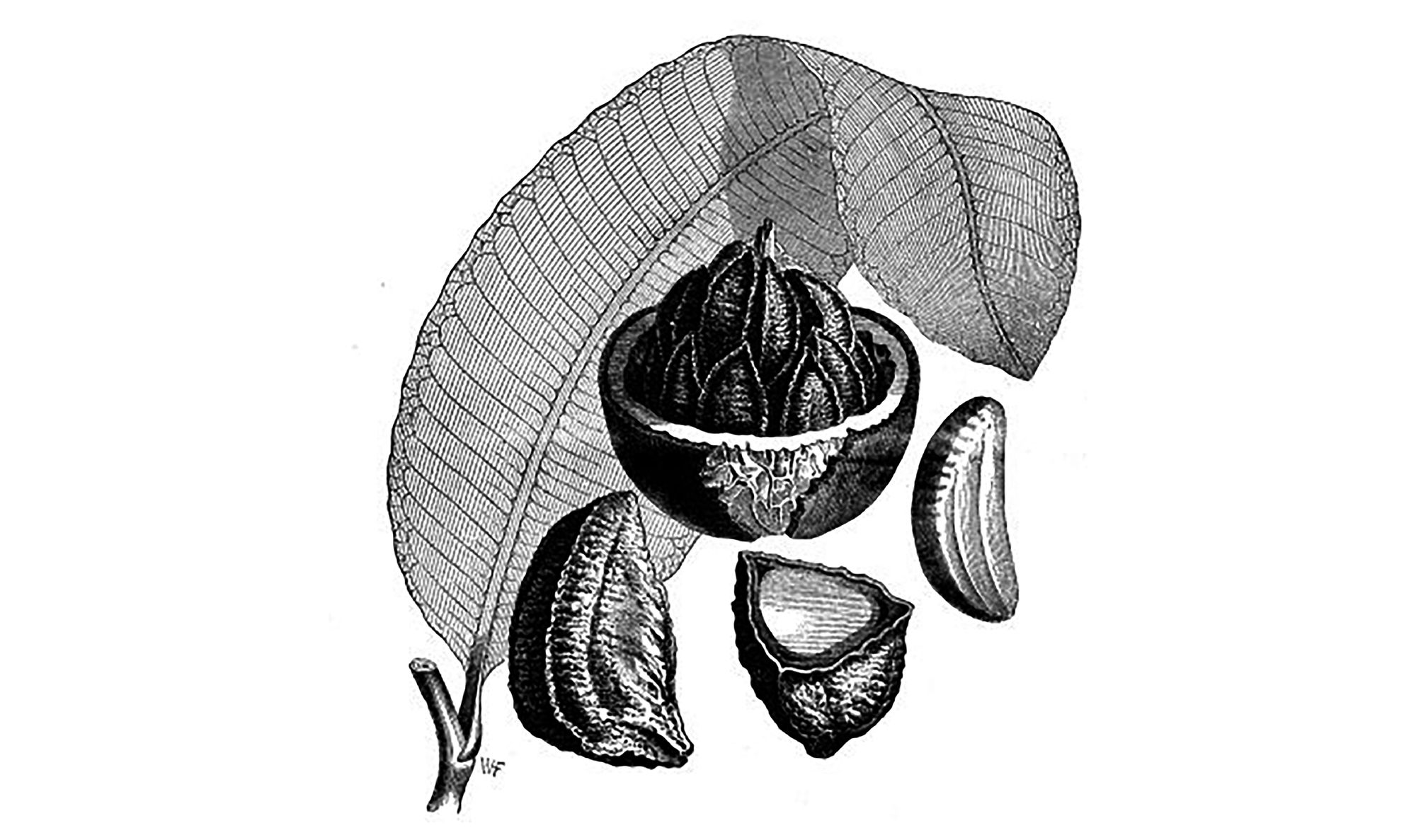
Bertholletia excelsa is a tree native to the Amazon rainforest. The German naturalist Alexander von Humboldt named it in 1808 after his friend, the French chemist Comte Claude Louis Berthollet. The word excelsa means “high” in Latin and could be attributed to the tree’s height reaching till 50 meters. This plant is extremely important for several indigenous and traditional people in the Amazon, appearing for example in the Apurinã myth of “Tsorá” that explains the origins of the world. Interestingly, for the Apurinã people, Mitatakury, the tree of big leaves and fruits, was already there before the world was created.
Extraction of Brazil nut is one of the main economic activities of indigenous people living in the region of the middle Purus River, in the South of the Amazonas state in Brazil. However, their relation to the tree is not only economic, as pointed out by the Anthropologist Mario Rique Fernandes from the Federal University of Amazonas (UFAM), but also social. In his PhD, Fernandes studied Apurinã’s idea of ancestry and historicity through their relationship to the territory and landscapes, where nut forests play an important role.
The Apurinã people are versed in the arts of nut extraction, an ancestral practice that demands physical endurance and a solid knowledge of the forest. Recent archeological findings prove that nut forests in the Amazon are directly connected to human presence; these forests are what archeologists and historical ecologists call “anthropogenic landscapes.” Brazil nut trees need sunlight to grow, which is best found in glades in the middle of the forest. According to researchers, this perfect development condition could be the result of either natural influences such as a storm, or the controlled opening of clearings for planting very common among indigenous and traditional communities.
According to Fernandes, Bertholletia excelsa appears in three episodes of Apurinã‘s “Story of Tsorá.” To have an idea of the importance of this legend to the Apurinã people, Fernandes explains, it means the same as the Bible for the Christians, being Tsorá equivalent to God. The myth tells the life story of the hero Tsorá and his siblings, describing how they create or transform vegetal and animal beings, “freezing” the world in the state currently experienced by the Apurinã people.
The author emphasizes that the Bertholletia excelsa is the only fruit tree mentioned in the myth that had not been planted by heroes; in other words, it was already there before the story of the world begins. Furthermore, Fernandes presents analogies in the myth that suggest the unity between Tsorá and the tree. Considering this equivalency and the parallel with the holy Bible, it is possible to speculate that both Bertholletia excelsa and Tsorá are God for the Apurinã people in the Amazon rainforest.
“Generalizing to a whole country the kinship relation of indigenous peoples of the Amazon Forest with Bertholletia excelsa is, in essence, honoring the same state that continues to expropriate their lands and to exterminate them.”
It is not necessary to go that far to recognize the importance of this tree to the people of the Amazon Forest. Once the beauty and the depth of this relationship is unveiled, it might sound ridiculous that the Brazil nut’s scientific name pays homage to a random friend of Humbold. Furthermore, generalizing to a whole country the kinship relation of indigenous peoples of the Amazon Forest with Bertholletia excelsa is, in essence, honoring the same state that continues to expropriate their lands and to exterminate them.
Fortunately, a new generation of scientists is trying to change this paradigm. In 2020, a petition sent to the American Ornithological Society (AOS) in the US demanded the renaming of bird scientific and common names that honor colonialists and genocides. The clamor was acknowledged by the association, and they committed to address this issue in the months to come. Another attempt to use the scientific naming system for good is made by the young Brazilian biologist Pedro Henrique Cardoso, from the Federal University of Rio de Janeiro. Cardoso celebrates two indigenous leaders in the name of the plants he found during his field work in Central and Southeast Brazil.
Lippia krenakiana honors the activist, philosopher, and author Ailton Krenak, “praising the importance of indigenous peoples in the conservation of our biodiversity,” says Cardoso. Lippia stachyoides var. guajajarana commemorates the activist, ambientalist, and politician, Sônia Guajajara, who was in 2018 the first indigenous person in the history of Brazil to run for Vice President. These initiatives show that changes aiming for more welcoming, equitable and decolonized sciences are not only necessary, but possible—and desperately needed.
Tai Linhares (she/her) is a Brazilian designer, filmmaker, visual artist, and coding enthusiast living in Germany. She has a master’s degree in Media Studies from the Federal University of Rio de Janeiro (UFRJ), and also studied Journalism at the same institution and Computer Sciences at the Technical University of Berlin (TU Berlin). In her latest art project called “named after Men”, she uses python programming to develop a story telling framework that helps to identify relationships between botanical sciences and colonialism. Her last short film, “Mixed Race” (Parda, 2019), is an essay that reflects about racial issues in her country of origin, mixing documentary and fiction story telling techniques. The film has been screened all over Brazil in the Mostra SESC de Cinema and has been featured in festivals in Germany, Portugal, Finland, Sweden, Ecuador, China, and Poland. Some of her topics of interest are fairness, sustainability, and decoloniality.










